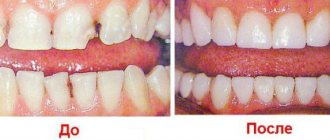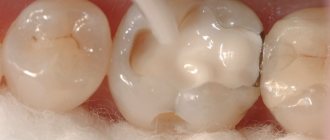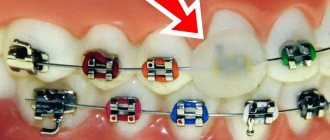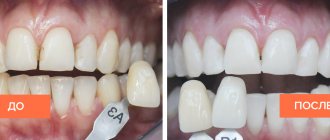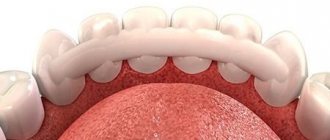At the initial stage of tooth decay, an enamel defect appears on its surface, which, in the absence of timely treatment, turns into a cavity. When visiting a dental clinic, the therapist resorts to filling - filling tooth defects or the resulting cavity with special filling materials. Today, dental clinics use various types of modern filling materials, each of which has its own characteristics, advantages and disadvantages. These can be cement, metal, or light-curing fillings.
Light-curing composite is the most popular material
Light-curing composites, also called polymers, are the most popular materials for restoring teeth damaged by caries in modern dentistry. In composites of this class, a polymerization reaction occurs under the influence of ultraviolet light.
Classification by curing mechanism
- chemically cured composites;
- hot curing (the polymerization reaction is initiated under the influence of high temperatures);
- cold curing (the reaction is initiated by a redox mechanism at room temperature);
- light curing.
Light-curing composites vary in paste consistency. They are divided into dense, or packable, as well as varieties of fluid or universal (medium) consistency.
Staging methods
There are two main methods of canal obturation using the products in question - cold and hot. The first involves lateral condensation of each inserted rod, which is at room temperature.
The method is recommended for channels that have a regular round shape, which ensures a good fit to the walls of the passage.
The required standard size of the rod is determined by the master file - the last tool with which the stock was prepared. The work is performed in the following sequence:
- A sealant (sealer) is applied to the walls of the prepared canal.
- The selected model is inserted into the stock (after installing it, it is recommended to make several reciprocating movements to remove air).
- The part protruding above the mouth is cut off.
- Vertical condensation is carried out using heated pluggers of several sizes, first large, then smaller.
- After the canal is completely filled, a temporary dressing is applied.
- After 1-3 days, the bandage is removed and a pad is placed, which is closed with a permanent filling.
Side condensation
The technology consists of sequentially introducing several products into the canal (usually 4-5 pieces) and pressing them against the walls of the bed with a spreader.
Procedure steps:
- The channel is coated with sealer. The recommended volume of adhesive is 5% of the volume of the obturator.
- The main rod is inserted.
- Lateral condensation is carried out using the screwing movements of the spreader.
- After removing the tool, another pin is installed and sealed in its place.
- The operations are repeated until the canal is completely filled with gutta-percha, after which the protruding ends of the rods are cut off and vertical condensation is carried out with a large hot plugger.
- A temporary dressing is applied and the gutta-percha is given 1-3 days to cure.
- At the next visit, the bandage is removed, a pad is placed, and a permanent filling is installed.
The main advantages of lateral condensation are simplicity and effectiveness, for which it is considered the “gold standard” of obturation.
Disadvantages of composites
The main disadvantage of composite materials is polymerization shrinkage, as a result of which the dimensions and concentration of internal stresses change. In addition, some of them have insufficient wear and color fastness.
High-viscosity (dense) composites have increased compressive strength and greater rigidity than other composites. They are characterized by less shrinkage, and changes in size with temperature fluctuations are practically no different from those of natural dental tissues.
Composites with a flowable consistency have improved aesthetic properties, but are less durable and exhibit increased shrinkage during curing. Their coefficient of thermal expansion is also worse than that of teeth.
Composites on posterior teeth are subject to rapid wear at contact points where the loads are highest. On the chewing teeth, a violation of the marginal seal is also observed. Therefore, it is recommended to use dense varieties with higher wear resistance.
Composite material consize
Recently, the recently developed new composite filling material consize has become popular. It has high aesthetics, good adhesion to fabrics and other materials.
But considering that with such a filling, the tooth enamel is treated with acid, it is imperative to apply an insulating gasket. The advantage of using this material is the absence of preliminary preparation.
Installation method
The surface is thoroughly cleaned using mechanical treatment. The etching liquid is applied for 1.5-2 minutes, after which the tooth
washed with clean water and dried thoroughly.
After this process, it is necessary to ensure that the tooth is isolated from saliva. The etched area will take on a pretty color. Then use a swab to mix two equal parts of liquid filling material and apply it to the area.
After this, mix two parts of the previously prepared paste and fill the cavity. When modeling, use a smoothing iron, and in case of significant defects, use a cellophane cap.
The excess should be eliminated before the conseise hardens. Hardening of the filling takes up to 8 minutes, after which you can begin mechanical processing. All materials, including paper towel and foam swabs, are included in the kit.
The article discusses modern filling materials most commonly used in dentistry. Before starting work, it is necessary to carefully determine the degree of the patient’s disease and dental defect.
Filling material Estelite
Since manufacturers use components with different consistencies in the manufacture of materials, it is necessary to read the instructions before starting filling. The hardening and thickening time of the mixture may vary slightly. But at the slightest deviation from the required conditions, the filling may lose the required properties.
Contraindications
Composite materials are contraindicated if the patient has toxic or allergic reactions to polymers, as well as with bruxism and parafunction. Relative contraindications include increased abrasion of antagonist teeth, as well as the presence in the oral cavity of antagonist teeth covered with crowns made of noble alloys.
Composite materials are an ideal solution for restoring anterior teeth when aesthetics are a priority rather than strength requirements due to the low chewing load. They retain the original shade, have good adhesion and a low rate of recurrent dental damage. An important nuance is that over time they lose their initial relief, since they are constantly exposed to abrasive wear during chewing, brushing teeth and exposure to the erosive environment in the oral cavity.
Paraformaldehyde
Pastes based on paraformaldehyde are used in dentistry for mummification and pulp devitalization. In 1959, Sargenti & Richter introduced a method of endodontic therapy that involved filling root canals with paraformaldehyde paste. Other proponents of paraformaldehyde pastes also strongly argued for their high antimicrobial activity in endodontic treatment. While traditional zinc oxide eugenol sealants are used in combination with solid fillers such as gutta-percha, N2, RC2B and Endomethosone, Spad and other paraformaldehyde pastes are recommended as the sole filling material, significantly increasing the volume of paste used. Thus, increased absorption and toxicity of paraformaldehyde pastes is a serious problem with their use. In many published studies of paresthesias and other complications of the inferior alveolar nerve after penetration of filling material into the mandibular canal, the cause in most cases was the irritating components of paraformaldehyde pastes. Brodin and other scientists have experimentally proven and demonstrated the neurotoxicity of paraformaldehyde compounds. In addition, Brodinetal. showed that among other materials, N2 causes the greatest disruption of nerve conduction in vitro. Scientists have recognized that it is necessary to limit the use of these materials in endodontics as more and more reports of dangerous complications are being published.
Due to higher risks of complications, materials such as N2 or similar are contraindicated for use. When a safer alternative therapy using traditional filling materials exists, it is not advisable to choose an unsafe technique.
Even the safest materials can lead to serious complications if used in large quantities. All known sealants can damage the maxillary nerve during extrusion or the mucous membrane of the maxillary sinus. (Figure 8a-c)
Figure 8 (a) “Acceptable” extension of zinc oxide eugenol sealant beyond the apex of a mandibular molar, demonstrating obturation and three-dimensional compaction to the apex, which is unlikely to affect the healing process. Courtesy of dr. John Munce. (b) Inadmissible release of paraformaldehyde paste into the mandibular nerve canal. The patient experienced symptoms such as a sore throat and loss of sensation, which required surgery several weeks later. Even after the tooth was removed and the remaining material was removed, the patient still experienced burning pain and loss of sensation.
Structure modification
The need for industrial and technological modification of hybrid compounds arose in connection with the need to create a separate space of microscopic fragments of filler, which includes both very small and larger elements.
The first ones fill the voids, allowing the mass to acquire characteristics that are very important in the field of dental prosthetics:
- resistance to abrasive external influences;
- polishability;
- high aesthetic content.
The second guarantees complete filling of the structure and ensures a high strength coefficient of the composition obtained using this technology.
Since microscopic fragments are located extremely unevenly in the mass, and they are also prone to sticking together, there was a need to create a unique innovation that allows obtaining the correct homogeneous distribution, as well as ensuring absolute coverage and impregnation of small compounds with resins.
Scientific developments in this area have led scientists to the need to form mixtures that have been modified with nanocomposites - hybrid materials.
The result is a more durable composition, with enlarged fragmented structures, with the same high resistance to premature wear and abrasion of the outer surface.
And although over time the surface shine is inevitably lost, this now happens an order of magnitude slower.


